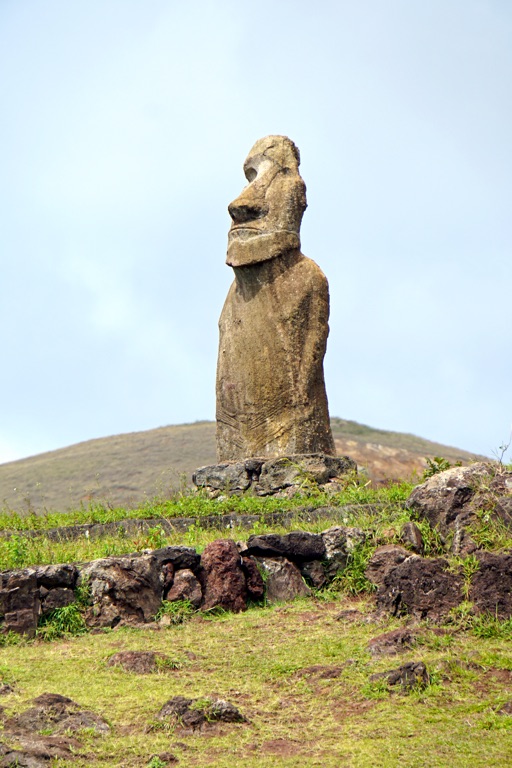Ahu Huri a Urenga is a significant archaeological site on Easter Island, known for its solitary moai statue. This site stands out due to its unique features and alignment with the winter solstice. It provides valuable insights into the Rapa Nui civilization and their astronomical knowledge. The moai’s distinct characteristics and the ahu’s construction reflect the island’s rich cultural heritage.
Get your dose of History via Email
Historical Background of Ahu Huri a Urenga
Archaeologists discovered Ahu Huri a Urenga in the 20th century. They found it on Easter Island, a remote Polynesian island. The Rapa Nui people built this ahu, a ceremonial platform with a single moai. The moai are famous for their massive stone figures. The Rapa Nui culture, which peaked between the 10th and 16th centuries, created these structures. Ahu Huri a Urenga’s moai is unique for its four hands, unlike others on the island.
William Mulloy, an American archaeologist, conducted extensive research on the site. He did so in the late 20th century. Mulloy’s work helped to restore Ahu Huri a Urenga and brought attention to its astronomical alignment. The Rapa Nui people inhabited the island for centuries. They developed a complex society known for its monumental architecture and artistry.
The site has not been the scene of any known historical events. However, it holds significant cultural importance for the Rapa Nui people. The moai and ahu are central to their religious and social life. The construction of these structures was a communal effort. It involved the entire population and reflected the society’s organization and beliefs.
Over time, the Rapa Nui civilization faced ecological challenges and social upheaval. This led to the decline of moai construction. Ahu Huri a Urenga, however, remains a testament to the ingenuity of the Rapa Nui. It showcases their ability to create monumental works with limited resources.
The site’s historical importance lies in its connection to the Rapa Nui’s astronomical knowledge. The moai’s alignment with the winter solstice sunrise suggests a sophisticated understanding of celestial movements. This knowledge likely played a role in agricultural practices and religious ceremonies.
About Ahu Huri a Urenga
Ahu Huri a Urenga is notable for its well-preserved ahu and moai. The ahu is a rectangular stone platform. It serves as the foundation for the moai statue. The moai at this site is unique for its four hands, a feature not found on any other statue on the island.
The moai was carved from volcanic tuff, a common material for these statues. The Rapa Nui people used stone tools called toki to shape the moai. They transported the massive figures across the island using a combination of sleds, rollers, and human strength.
The ahu’s construction involved fitting large stones together without mortar. This technique showcases the Rapa Nui’s skill in stonemasonry. The moai’s placement on the ahu required precise engineering and communal effort. The statue’s eyes were once inlaid with coral and obsidian, adding to its imposing presence.
Architectural highlights of Ahu Huri a Urenga include the moai’s detailed carvings and the ahu’s alignment. The moai’s posture, with one hand resting on the stomach and the other on the knee, is typical of many moai on the island. However, the presence of two additional hands sets it apart.
The ahu’s alignment with the winter solstice sunrise is one of its most intriguing features. This alignment suggests that the Rapa Nui used the site for astronomical observations. It may have had a ceremonial purpose related to the solstice.
Theories and Interpretations
Several theories exist about the purpose of Ahu Huri a Urenga. The most prominent theory relates to its astronomical alignment. Researchers believe the Rapa Nui used the site to mark the winter solstice. This event was significant for agricultural and ceremonial reasons.
Some mysteries surround the site, such as the significance of the moai’s four hands. Scholars have yet to reach a consensus on this feature’s meaning. It may represent a specific ancestor or deity, or it could have a symbolic function within the Rapa Nui religion.
Interpretations of Ahu Huri a Urenga often rely on comparisons with other ahu and moai. Researchers match these findings to oral traditions and historical records. This helps to piece together the site’s cultural and religious significance.
Dating of the site has been carried out using radiocarbon methods. These methods analyze organic materials found in association with the ahu and moai. The results suggest that the Rapa Nui constructed Ahu Huri a Urenga around the 13th century.
The site continues to be a subject of study for archaeologists and historians. They aim to understand the Rapa Nui civilization better. Theories evolve as new discoveries are made and existing evidence is reevaluated.
At a glance
Country: Chile
Civilization: Rapa Nui
Age: Approximately 13th century AD
Conclusion and Sources
Reputable sources used in creating this article:

